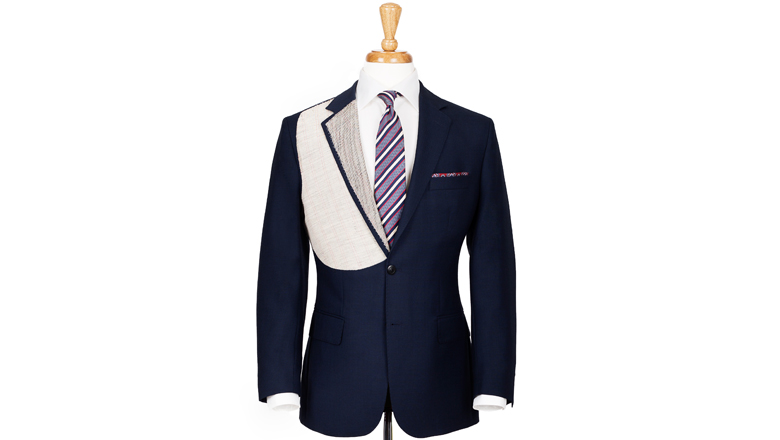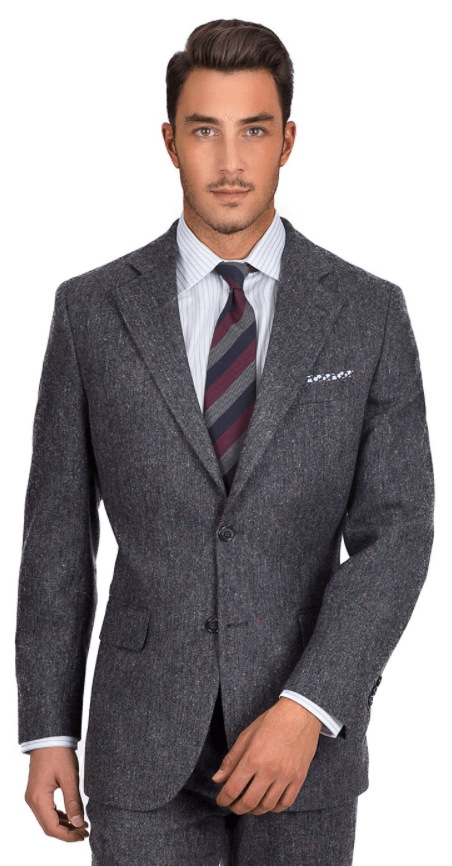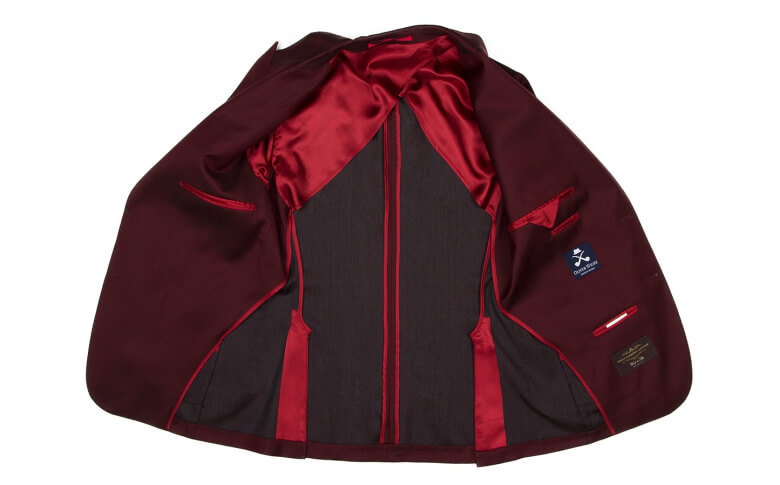FULL CANVAS VS HALF CANVAS - WHICH SUIT JACKET CONSTRUCTION IS RIGHT FOR YOU?
By Paul Briden

Buying a new made-to-measure suit can be a daunting experience, not least because of the sheer number of options that come with the customization process. Acquiring a bespoke suit presents you with choices you simply don’t have when buying an off-the-rack suit in a retail store.
On top of that, there’s the jargon; different features of a suit’s design have specific names that aren’t always familiar, and before you know it, your head can be spinning from the overwhelming onslaught of specialist terminology.
Fear not! Today, we’re here to help you learn just two of those little-known specialist terms, because they can make all the difference in the appearance, quality, and durability of your suit. Ready? Half canvas versus full canvas. Now, if you’ve never debated the merits of a half canvassed suit or fully canvassed suit, or if you don’t know the difference between a canvassed men’s suit and a fused suit, read on. By the end of this article, you’ll be well on your way to making an informed choice on the perfect suit for you.
There’s a lot of info in this article, so we’ve made this table of contents to make quick navigation a breeze!
What Is Canvas?
The term “canvas” is one that many people don’t encounter until venturing into the world of made-to-measure, tailor-made, or bespoke suiting, so it can be a source of much confusion. More specifically, “canvas” refers to what is also known as a “canvas Interlining”.
At Oliver Wicks, all our suits are carefully crafted with a Half Canvas construction as standard, but clients can choose a Full Canvas construction instead if they wish. What’s the point of a canvas interlining? What’s the difference between half canvas vs full canvas? We’re glad you asked.
The canvas interlining is typically made from horsehair (often blended with cotton) or synthetic fabric. As the word “Interlining” suggests, a layer of this fabric is sandwiched between the cloth you see on the outside, and the lining you see on the inside.
The purpose of the canvas interlining is to give the suit jacket support and shape, a bit like a skeleton. Indeed, this internal layer (along with other hidden components, such as shoulder padding) is also often referred to as a suit’s “structure”.

Canvas helps the jacket sit, hang and fit better on your body (this is known as the “drape”) and allows the suit to ultimately achieve what it’s designed for: accentuating the shape of the masculine physique. What’s more, this means a well-made suit with a canvas construction will actually feel and look better with age - think of it like a good single malt.
Half canvas construction
As you can see from the diagram, the half canvas construction quite literally extends from the padded shoulder to about halfway down the jacket body. This allows for a robust and well-shaped shoulder structure - a very important part of a well-fitting jacket - and also ensures the jacket tapers elegantly towards the waist.
Because it requires considerably less work than a fully canvassed suit, a half canvassed suit is a cheaper option that still provides much-needed structure. It will feel noticeably more robust and comfortable, and will be better-fitting than a fused suit without canvas (certainly more so than an unstructured jacket). At the same time, a half canvassed suit is also lighter and less structured than a fully canvassed suit. With that said, many customers actually prefer the lighter weight and less-structured feel of a half canvas suit jacket, especially in warmer weather.

Half Canvas Suit Options at Oliver Wicks
Whether you’re snapping up a classic professional suit for business, or a casual blazer to project your style among friends, we stand by our view that our standard half canvas construction is the perfect path to follow for the majority of customers. It just looks right, and equally as important, feels ‘right’.

With luxurious Italian fabric, a half canvas construction, and a price tag that won’t upset your bank account, our number one best-selling suit is the Navy Pick & Pick (shown above). If you require just one suit in your wardrobe, this would be our recommendation; it’s the most versatile all-rounder for formal wear, casual wear, and everything in between.
Full canvas construction
The full canvas option extends further down the jacket’s front, adding additional structure and weight and allowing the suit jacket to mold more accurately to your shape with a superior drape. In short, a full canvas suit will fit better than any other option.
Canvas also improves the durability of a jacket by distributing tension from stress points (such as the elbows and shoulders). Canvas construction also helps a bespoke suit cope with the rigors of dry cleaning, and of course, a full canvas suit means more canvas interlining to provide durability.
The only real downside to a full canvas suit is the added cost, as its construction is a more involved and lengthy process. However, there is once again an element of personal preference here: a fully canvassed suit jacket does feel heavier and more structured on the body. While some customers prefer this, others favor the more lightweight feel of a half canvas suit.

A great time to consider a full canvas construction is for your winter collection suits, like our Natural Brown Tweed (above). Not only will you benefit from the extra durability, but having the extra material will also add to the jacket's warmth.
Full Canvas Suit Options at Oliver Wicks
As an optional extra during your customization selection, we can boost any suit jacket or blazer with a substantial full canvas skeleton. Some customers prefer this option throughout their year-round collection, but even if that’s not you, we’d still recommend considering full canvas construction as a practical upgrade for your Autumn and Winter suits. You’ll be thankful for the additional warmth and structure when the wicked winter winds blow.

An ideal candidate for full canvassing would be something like this 10.5oz heavyweight Dark Grey Donegal Tweed Suit (shown above), which is available from our Autumn/Winter range.
Full Canvas Suit Brands
Search the web, and you’ll find that many suit tailoring brands are offering fully canvassed suits. The catch: more often than not, these suits come at a hefty cost.
People sometimes dive into the second-hand suit market and get lucky, but we believe that it should be possible to own a brand new, fully canvassed suit that is also tailored specifically to your measurements at a reasonable price.
Canvassed & Pad-Stitched Lapels
Our half canvas and full canvas construction suits both extend the canvas into the jacket lapels, which are pad-stitched. This is vital for giving them the correct shape and support, as well as enabling a smooth lapel roll.
Now, what’s a lapel roll and why do you want a smooth one? Good question.
If you look at the front of a suit jacket, you’ll notice that the lapel is actually a section of the jacket that is turned back on itself, from the collar down to the button at the waist. The term “lapel roll” refers to this length of turned-back, or “rolled,” fabric. On a poorly-made suit that lacks a proper canvas structure, the lapel is quite often pressed flat with a crease, lacking any of the attractive and gently curving “roll” whatsoever.
A Word On “Fused” Suits
The parts of the suit jacket body which are not canvassed (as per the diagram at the very top of the article) use a “fused” interlining; this is a composite of various materials which are fused, or laminated, together via a heat treatment process. The fusing is physically pressed to the cloth with small amounts of adhesive between 266-300F (130-149C for our European readers).
The purpose of fusing is to stiffen the fabric slightly, and fused linings are quicker, cheaper, and easier to produce than canvassing. However, fused linings do not provide the same quality finish as true canvas. Therefore, if you’re looking for a good quality suit, the less fused material, and the more canvas, the better.
Having said that, the fusing process has been refined considerably with modern textile technology and materials. In the past, there were sometimes problems with delamination, and you may have heard horror stories of suits “bubbling” over time.
We wouldn’t be surprised if you’re currently thinking “So why use any kind of fusing at all if it’s so bad?” The answer is that adding small amounts of fusing, in addition to a full or half canvas construction, results in a longer lifespan for many of the lighter-weight suit fabric options that we offer.
Thankfully, this kind of delamination isn’t something to worry about so much these days, and using some fusing in a suit’s construction is normal, and indeed in many cases, desirable to reduce costs.

What is common but not so desirable though, is suits which are entirely fused. Suits with no Canvas Interlining whatsoever are known as “fully fused”. Here at Oliver Wicks, we do not offer a fully fused suit option. The fusing we do use in our Half Canvas and Full Canvas options is a thin layer of what’s called “skin-fusing”, which is lighter and very unlikely to delaminate or bubble.
Many brands (and no, we won’t name names!) also offer HalfCanvas suit options that lack the important canvas structure and pad-stitching in the lapels - this can sometimes be referred to as a floating chest piece. These suits may have a piece of canvas, possibly with some felt fabric and other materials, inside the chest, while the rest of the suit is fused, including the lapels. Again, this lack of support in the lapels makes them flat, floppy, and lifeless.
Conclusion
The days when poor quality fusing bubbled and ruined many jackets are mostly gone, but you should generally stay away from fully-fused garments.
If such shortcuts are taken on the structural integrity of the jacket, then it’s highly likely that other compromises were also made in the sourcing of the fabrics and trimmings, and in the general construction of the jacket or suit.
Go with our default half canvas construction for an excellent roll of the lapel and a light drape - or upgrade to a full canvas suit for a more structured feel, or to add further warmth for colder weather.
